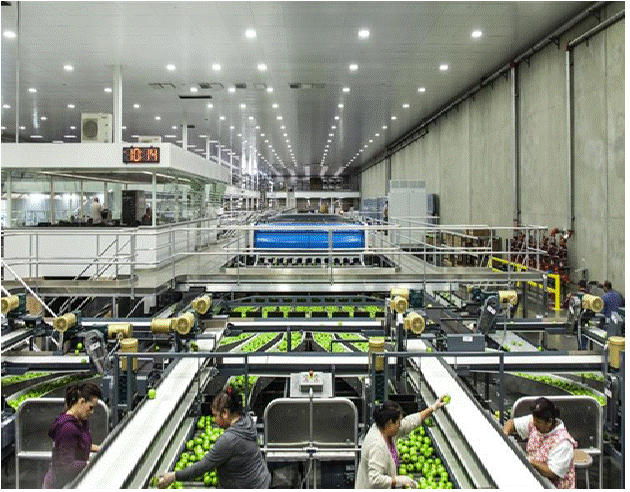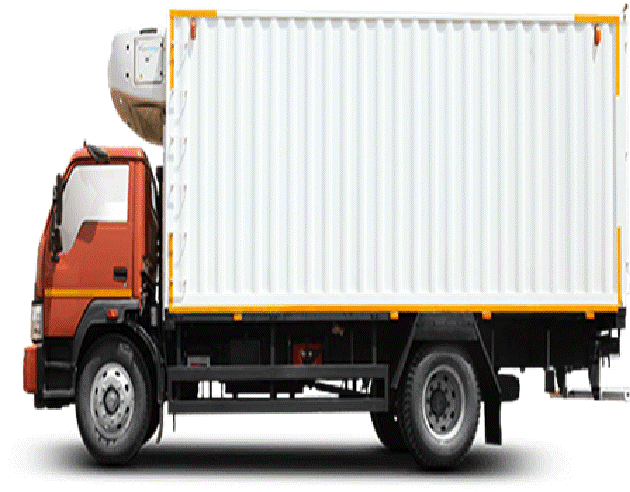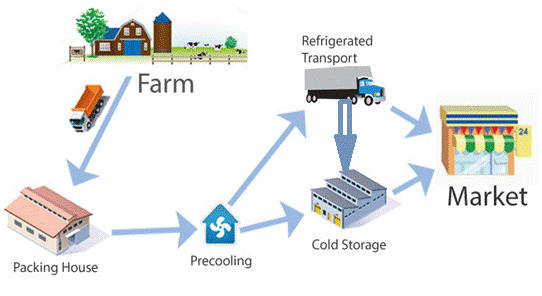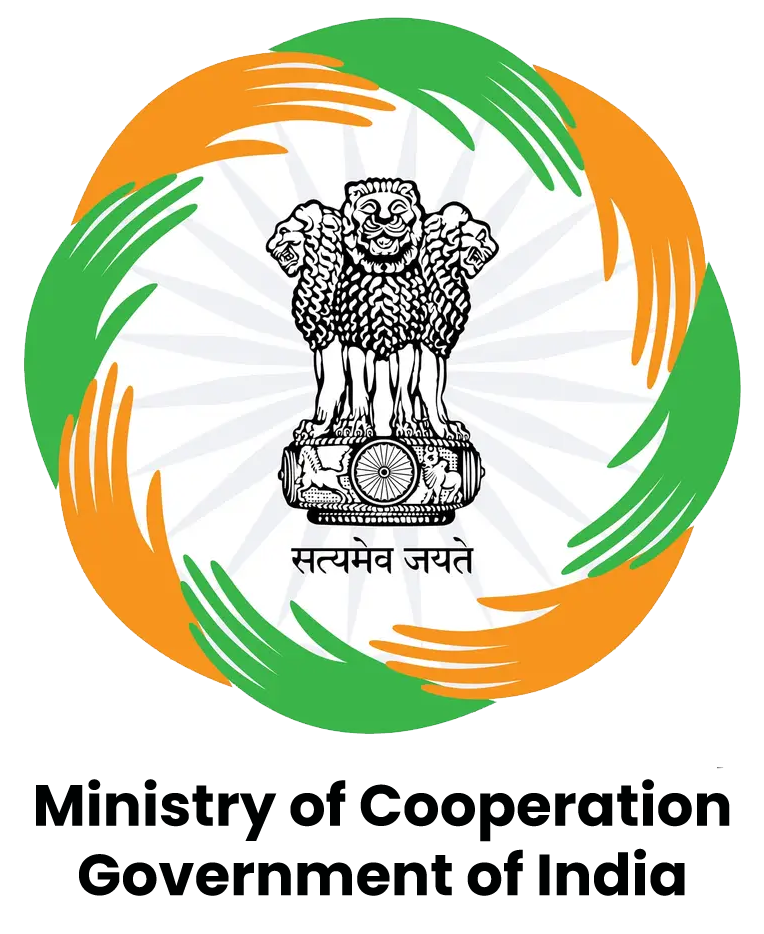Cold Chain is an uninterrupted temperature-controlled logistic chain, ensuring market link from farm gate to the consumer. It is a kind of supply chain that is specialized in the storage, transport, and preservation of cargo that needs to be maintained at a specific temperature or within an acceptable temperature range, humidity, etc. It is used to preserve and extend the shelf life of products, such as fresh agriculture produce, seafood, frozen food, photographic film, chemical and pharmaceutical drugs. Such products during transport and when in transient storage, are sometimes called cool cargo. Unlike other goods or merchandise, Cold Chain goods are perishable and always en route towards end use or destination, even when held temporarily in cold stores and hence commonly referred to as cargo during its entire logistics cycle.
Eligible Cooperative Societies:
NCDC provides assistance to primary, district and state level cooperatives.
Major Components of Cold Chain:
-
Modern Pack Houses with Pre-coolers and a small cold room
Modern pack house is an infrastructure, built close to farm gate, with facilities of conveyor belt system for sorting, grading, washing, drying, weighing, packaging, pre-cooling, etc. Pre- cooling unit is specialized cooling system designed to rapidly remove field heat from freshly harvested produce and thereby prepares the fruits and vegetables and other perishables for subsequent travel in the cold chain. Cold room temporarily stores preconditioned fresh produce, awaiting transport link to a distribution point and is a necessary attachment to a pre-cooling unit.

-
Transportation (Refrigerated / normal ventilated trucks depending product)
Refrigerated transport is an insulated carrier equipped with active refrigeration, designed for temperature-controlled carriage of perishable products. This can include refrigerated trucks, vans, rail, containers, and ships for transporting perishable products.

- Cold Storage (Bulk) at farm gates for long term inventory
-
Cold Storage (Hub) near Consumption Centres as a distribution platform
Cold storage is static infrastructure designed with insulated and refrigerated chambers for long term or transient storage of fresh, ready-to- retail, or processed forms of perishable products. -
Ripening Units
They are near markets/consumption centres, mainly used for banana, mango, and papaya.
Advantages of Cold Chain:
India is the second largest producer of fruits and vegetables globally. As per a study conducted by Central Institute of Post Harvest Engineering and Technology (CIPHET), harvest and post-harvest losses including losses during storage for fruits and vegetables were in the range of 5% to 16% which is huge. Therefore, establishment of Cold Chain units is of paramount importance and has the following advantages:
-
Reduces the loss of agricultural and other perishable commodities like fruits & vegetables, meat, meat products, sea food, food, etc. till it reaches the consumers.
-
Preserves and extends the shelf life and safeguards the nutrient quality of products.
-
Improves domestic food supply, leads to improved nutrition and food safety, adds to farmers income and helps in lowering market price for local population
-
New jobs would be created all along the Cold Chain.
Role of NCDC in Cold Chain Development:
NCDC is a nodal agency of the Government of India for implementing schemes of various ministries. As such, NCDC will make all efforts to avail subsidy from all the Ministries of the GOI for the benefit of cooperative Cold Chain projects. However, for one Cold Chain project, subsidy can be availed from one source only. Most of the programmes of GOI for development of Cold Chain projects are credit linked back ended subsidy schemes. This means that the cooperative has to first tie-up all the loan requirements for its Cold Chain programme and only then it is eligible for subsidy. Here comes the role of NCDC, which can provide loan assistance at the attractive rate of interest for creation of Cold Chain facilities and dovetail the same with the grant-in-aid assistance from the Government of India.
As on 31.03.2023, 317 cold storage projects have been sanctioned with a capacity of 9.69 lakh MT and 3 Cold Chain projects with standalone infrastructure capacity of 18180 MT have been sanctioned. Against this, 306 cooperative cold storage projects with a total capacity of 9.35 lakh MT assisted by NCDC have been completed / installed. This includes 36 projects of capacity expansion of 1.28 lakh MT.
Cold Chain Schemes:
-
Integrated Post Harvest Management projects through National Horticulture Board (NHB): Credit linked back ended subsidy @ 35% of project cost limited to Rs.50.75 lakh per project in general areas and @ 50% of project cost limited to Rs.72.50 lakh per project in Hilly, North East & Scheduled Areas, is provided under NHB schemes for establishment of integrated pack house, pre-cooling units, cold room, mobile pre-cooling unit, ripening chambers and refrigerated transport vehicle. Pattern of assistance under Integrated Post Harvest Management projects will be as under:
General Areas North East, Hilly and Scheduled Areas NCDC to S/Govt. S/Govt. to Society Direct Funding NCDC to S/Govt. S/Govt. to Society Direct Funding Loan 55%
BES* 35%Loan 45%
SC 10%
BES* 35%Loan 55%
BES* 35%Loan 40%
BES* 50%Loan 30%
SC 10%
BES* 50%Loan 40%
BES* 50%Members’ Contribution
10%
10%
10%
10%
10%
*Back Ended Subsidy subject to availability from Government of India / NHM / NHB otherwise equivalent loan from NCDC for that particular Cold Chain component.
** State Government may contribute as a share capital or as a loan as per there financial condition.
However, higher subsidy is available for some small components, like small pack house with size of 9 M*6 M, evaporative/low energy cool chamber (8 MT), preservation unit (low cost), low cost onion storage structure (25 MT) and Pusa Zero energy cool chamber (100 kg), and in their cases 50% of the total cost is provided as subsidy. -
Capital Investment Subsidy Scheme of National Horticulture Board (NHB):Credit linked projects relating to construction / expansion / modernization of Cold Storages including Controlled Atmosphere (CA) and their modernization are eligible. Assistance for setting up of new Cold Storage infrastructure will be available only to Multi-Chamber cold Storage units with technologies which are energy efficient with provision of thermal insulation, humidity controlled, advance cooling systems, automation, etc, having specification and standards approved by the Ministry of Agriculture & Farmers Welfare. In case of CA Stores, projects of temperate fruit crops located in production areas for which to NHB protocols are available, are only are allowed. The assistance will be given as subsidy @ 35% of the capital cost of project in general areas and 50% in case of NE, Hilly States & Scheduled Areas for a storage capacity above 5000 MT up to 10000 MT. In case of North East states, projects with a capacity of 1000 MT or above are also eligible for application and consideration. Maximum permissible subsidy will be Rs.7.50 crore per project. Pattern of assistance under Capital Investment Subsidy scheme will be as under:-
| General Areas | North East, Hilly and Scheduled Areas | ||||
|---|---|---|---|---|---|
| From NCDC to State Govt. | S/Govt. to Society | Direct Funding | From NCDC to State Govt. | S/Govt. to Society | Direct Funding |
|
Loan 55% |
Loan 45% |
Loan 55% |
Loan 40% |
Loan 30% |
Loan 40% |
|
Member’s |
10% |
10% |
10% |
10% |
10% |
*Back Ended Subsidy subject to availability from Government of India / NHM / NHB otherwise equivalent loan from NCDC for that particular Cold Chain component.
** State Government may contribute as a share capital or as a loan as per there financial condition.
-
Agricultural Marketing Infrastructure (AMI) Sub Scheme of Integrated Scheme for Agriculture (ISAM) - for Non – Storage Infrastructure Projects
Funding pattern under AMI scheme:- - (Rs. in lakh)
| Category | Rate of Subsidy on Capital Cost | Maximum Subsidy Ceiling |
|---|---|---|
| A) North Eastern States, Sikkim, A& N, Lakshadweep Islands, Hilly* and tribal areas. | 33.33% | 30.00 |
| B) Other Areas | ||
| 1. For Registered FPO’s, Panchayat Raj Institutions, Women farmers/ entrepreneurs, SC/ST entrepreneurs and their cooperatives** | 33.33% | 30.00 |
| 2. For all others | 25% | 25.00 |
-
Through Ministry of Food Processing Industries (MoFPI):
In the case of Cold Chain scheme of MoFPI, cost norms of MIDH/NHB/NHM scheme will be followed wherever applicable. Pattern of assistance will also be same as given in the above table. For facilities not covered under MIDH guidelines, cost norms as determined by the MoFPI will be followed. For value addition and processing infrastructure including frozen storage / deep freezers associated and integral to the processing, grant-in-aid 50% for General Areas and 75% for North-East, Hilly States, & difficult areas, will be provided. Maximum grant-in-aid under Cold Chain scheme of MoFPI would be Rs.10 crore per project. Further details can be checked from the Ministry’s website www.mofpi.nic.in.
In addition to assisting the cooperatives in setting up of Cold Chain infrastructure/ components as per the pattern of assistance given above, NCDC also provides working capital assistance for undertaking business operations by the cooperative assisted for Cold Chain facilities.
All project proposals assisted under MIDH/NHM/NHB various schemes for setting up of Cold Chain infrastructure/components are required to comply, without fail, with the extant specifications standards and protocols on Cold Chain components prescribed by them and as revised and updated from time to time by any authorized agency like National Centre for Cold Chain Development (NCCD), etc., otherwise subsidy may be refused by the above agencies. The State Governments/societies may be requested to adhere to the technical standards and protocols etc. while preparing the Detailed Project Report for assistance for setting up of Cold Chain infrastructure/components. In order to claim subsidy from NHB, time limit for completion of the project would be maximum of 18 months period from the date of disbursement of 1st instalment of term loan, which may be extended for a period of 3 months, if reasons for delay are considered justified by NCDC and agreed to by NHB.
Other than the above mentioned schemes NCDC also provides financial assistance for Pradhan Mantri Matsya Sampada Yojana (PMMSY).
Mode of Funding:
Financial assistance is provided through the State Govt. or directly to the eligible cooperatives.
Quantum of Assistance and Pattern of Assistance:
Varies from activity to activity and upto 90-95% of the total cost for the most of the activities. However, in case of strengthening of share capital base/margin money/working capital assistance, the quantum of assistance can be upto 100%.
For detailed pattern of assistance please click at the link provided.
Yuva Sahakar - Cooperative Enterprise Support and Innovation Scheme:
To encourage newly formed cooperatives take advantage of innovative ventures, especially by societies with new/innovative idea, NCDC has introduced a new scheme titled, “Yuva Sahakar - Cooperative Enterprise Support and Innovation Scheme” linked to a Cooperative Start-up and Innovation Fund created by NCDC. Please click for details of the Scheme.
Norms for direct funding:
Cooperatives operating for minimum three years & broadly fulfilling following criteria are eligible:
(i) Net worth should be positive.
(ii) There should be no erosion in share capital.
(iii) Should be in a position to provide 1.25 to 1.5 times security.
(iv) Financial /operational performance of the cooperative should be at satisfactory level of NCDC.
For detailed norms of Direct Funding please click at the link provided.
Common Loan Application Form for availing assistance under the scheme of NCDC can be downloaded from NCDC’s website.
For further details, please contact or write to:
Cold Chain Division
National Cooperative Development Corporation,
4, Siri Institutional Area, Hauz Khas,
New Delhi – 110 016
Tel No.: +91-011-20862512, 20862866, 20862490, 20862801
Fax: +91-011-26962370, 20862619, 26602568
Website: www.ncdc.in Email: mail ncdc.in
ncdc.in
Regional Directorates of NCDC: Bengaluru, Bhopal, Bhubaneswar, Chandigarh, Chennai, Dehradun, Gandhinagar, Guwahati, Hyderabad, Jaipur, Kolkata, Lucknow, Patna, Pune, Raipur, Ranchi, Shimla, Thiruvananthapuram
Frequently Asked Questions (FAQ)
COLD CHAIN
1. What is a Cold chain?
An environmentally controlled logistics chain, ensuring uninterrupted market link from farm-gate to the consumers. It consists of refrigerated storage and distribution related activities in which the crop/produce is maintained within predetermined ambient parameters relating to temperature, humidity, etc.

2. What are the major components of Cold chain?
i) Modern Pack Houses with Pre-coolers and a small cold room.
ii) Transportation (Refrigerated / normal trucks depending on product).
iii) Cold Storage (Bulk) at farm gates for long term inventory.
iv) Cold Storage (Hub) near Consumption Centres as a distribution platform.
v) Ripening Units.
3. What is a Cold Storage?
A frozen storage system with installed and refrigerated chamber is called cold storage. It is a large warehouse building for long term storage of bulk quantity of agricultural produce and other perishable commodities.
4. What is the difference between Cold Storage and Cold chain?
Cold storage is a static part of Cold chain which can help in preservation of perishable commodities. On the other hand, Cold chain actually helps in marketing of those commodities at a lucrative price in distant markets which is more important for the farmers and a necessary requirement.
5. What are the advantages of Cold chain?
i) Reduces the loss of agricultural and other perishable commodities like food, fruits & vegetables meat, meat products, seafood, etc. till it reaches the consumer.
ii) Preserves and extends the shelf life and safeguards nutrient quality of products.
iii) Improves domestic food supply, leads to improved nutrition and food safety, adds to farmer’s income and helps in lowering market price for local population.
iv) New jobs would be created all along the Cold chain.
6. Whether all the Cold chain components are necessary in every Cold chain project?
No. Every Cold chain project will have components as per its own requirements. Thus, assistance can be availed for a combination of two or more Cold chain infrastructure components by a cooperative, within the prescribed norms of individual items.
7. Role of NCDC in Cold chain development?
NCDC is a nodal agency of the Government of India for implementing schemes of various Ministries. As such, NCDC will make all efforts to avail subsidy from all the Ministries of the GOI for the benefit of cooperative Cold chain projects. However, for one Cold chain project, subsidy can be availed from one source only.
Most of the programmes of GOI for development of Cold chain projects are credit linked back ended subsidy schemes. This means that the cooperative has to first tie-up all the loan requirements for its Cold chain programme and only then it is eligible for subsidy. Here, comes the role of nodal agencies like NCDC from which loan assistance can be availed and thereafter subsidy can be dovetailed for the project.>
8. What are the schemes of NCDC for Cold chain?
- Through Mission for Integrated Development of Horticulture (MIDH) / National Horticulture Board (NHB) / National Horticulture Mission (NHM) : After tying up the loan portion, subsidy @ 35% of project cost limited to Rs. 50.75 lakh per project in General Areas and @ 50% of project cost limited to Rs. 72.50 lakh per project in Hilly, North East and Scheduled areas is provided for Cold chain components as given in question no. 2 above. However, higher subsidy is available for some small components, the details of which and the details of cost norms, pattern of assistance, operational guidelines, etc. may be seen at websites like www.midh.gov.in, www.nhb.gov.in.
- Through Ministry of Food Processing Industries (MoFPI) : For development of Cold chain infrastructure, the quantum of subsidy will be the same as in the case of MIDH/NHB/NHM. However, for value addition and processing infrastructure including frozen storage/ deep freezers associated and integral to the processing, grant-in-aid @ 50% for General Areas and @ 75% for North East States, Himalayan States, ITDP Areas & Islands, will be provided. Maximum grant-in-aid would be Rs. 10 crore per project.
9. Procedure for availing financial assistance from NCDC?
The cooperative society should prepare a Detailed Project Report (DPR) with all the financials and submit the same to the NCDC. The cooperative may submit its proposal either through the State Government with their guarantee or the societies which fulfil direct funding guidelines of NCDC may apply directly to NCDC for sanction of assistance. Direct funding guidelines of NCDC are available on NCDC website i.e. www.ncdc.in. If the proposal of the cooperative is found in order, technically feasible and financially viable by the NCDC, loan component for the project shall be sanctioned by NCDC. Thereafter, full guidance will be provided by the NCDC to the cooperative for their sanctioned projects in availing loan as well as subsidy.
For further guidance regarding the Cold chain programme, visit the following websites: www.ncdc.in,www.midh.gov.in ,www.nhb.gov.in


